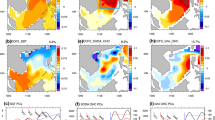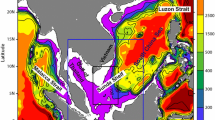Abstract
Decadal variability of the South China Sea (SCS) sea surface temperature (SST) during 1982–2014 is investigated using observations and ocean reanalysis datasets. The SCS SST shows an abrupt transition from a cold-to-warm regime in the late 1990s. Based on the long-term SST variability two epochs are defined, 1982–1996 and 2000–2014 as cold and warm regimes respectively, spanning on either side of the 1997–1999 SCS warming. Despite the occurrence of strong El Nino induced warming events, the SST anomalies tend to be negative in the cold regime. Conversely during the warm regime, the positive SST anomalies have dominated over the La Nina driven cooling events. The cold (warm) SST regime is marked by net heat gain (loss) by the SCS. The long-term variations of net surface heat flux are mainly driven by the latent heat flux anomalies while the short wave flux plays a secondary role. Low-frequency variability of the South China Sea throughflow (SCSTF) appears to be closely related to the SCS SST regime shift. The SCSTF shows reversing trends during the cold and warm epochs. The weakened SCSTF in the warm regime has promoted the SCS warming by limiting the outward flow of warm water from the SCS. Meanwhile, enhanced SCSTF during the cold regime acts as a cooling mechanism and lead to persistent negative SST anomalies. The change in trend of the SCSTF and SST regime shift coincides with the switching of pacific decadal oscillation from a warm to cold phase in the late 1990s.






Similar content being viewed by others
References
Berry DI, Kent EC (2009) A new air–sea interaction gridded dataset from ICOADS with uncertainty estimates. Bull Am Meteorol Soc 90:645–656
Berry DI, Kent EC (2011) Air–sea fluxes from ICOADS: the construction of a new gridded dataset with uncertainty estimates. Int J Clim 31:987–1001
Carton JA, Giese BS (2008) A reanalysis of ocean climate using Simple Ocean Data Assimilation (SODA). Mon Weather Rev 136:2999–3017
Chen J-M, Chang C-P, Li T (2003) Annual cycle of the South China Sea surface temperature using the NCEP/NCAR reanalysis. J Meteorol Soc Jpn 81:879–884
Cheng X, Xie S-P, Du Y, Wang J, Chen X, Wang J (2015) Interannual-to-decadal variability and trends of sea level in the South China Sea. Clim Dyn. doi:10.1007/s00382-015-2756-1
Chu PC, Lu S, Chen Y (1997) Temporal and spatial variabilities of the South China Sea surface temperature anomaly. J Geophys Res 102:20937–20955
Dong B, Dai A (2015) The influence of the interdecadal pacific oscillation on temperature and precipitation over the globe. Clim Dyn 45:2667–2681
Fang G, Chen H, Wei Z, Wang Y, Wang X, Li C (2006) Trends and interannual variability of the South China Sea surface winds, surface height, and surface temperature in the recent decade. J Geophys Res 111:C11S16. doi:10.1029/2005JC003276
Fang G, Wang Y, Wei Z, Fang Y, Qiao F, Hu X (2009) Interocean circulation and heat and freshwater budgets of the South China Sea based on a numerical model. Dyn Atmos Ocean 47:55–72
Feng J, Wang L, Chen W (2014) How does the East Asian summer monsoon behave in the decaying phase of El Niño during different PDO phases? J Clim 27:2682–2698
Gu D-J, Li T, Ji Z-P, Zheng B (2010) Connection of the South China Sea summer monsoon to maritime continent convection and ENSO. J Trop Meteorol. doi:10.3969/j.issn.1006-8775.2010.01.001
He H, Yang J, Gong D, Mao R, Wang Y, Gao M (2015) Decadal changes in tropical cyclone activity over the western North Pacific in the late 1990s. Clim Dyn 45:3317–3329
Kim YY, Qu T, Jensen T, Miyama T, Mitsudera H, Kang H-W, Ishida A (2004) Seasonal and interannual variations of the North Equatorial current bifurcation in a high-resolution OGCM. J Geophys Res. doi:10.1029/2003JC002013
Klein SA, Soden BJ, Lau N-C (1999) Remote sea surface variations during ENSO: evidence for a tropical atmospheric bridge. J Clim 12(4):917–932
Liu Q, Jiang X, Xie S-P, Liu WT (2004) A gap in the Indo-Pacific warm pool over the South China Sea in boreal winter: seasonal development and interannual variability. J Geophys Res 109:C07012. doi:10.1029/2003JC002179
Liu QY, Huang RX, Wang DX (2012) Implication of the South China Sea throughflow for the interannual variability of the regional upper-ocean heat content. Adv Atmos Sci 29(1):54–62
Liu Q-Y, Wang D, Wang X, Shu Y, Xie Q, Chen J (2014) Thermal variations in the South China Sea associated with the eastern and central Pacific El Niño events and their mechanisms. J Geophys Res 119:8955–8972
Mantua NJ, Hare SR, Zhang Y, Wallace JM, Francis RC (1997) A Pacific interdecadal climate oscillation with impacts on salmon production. Bull Am Meteorol Soc 78:1069–1079
Metzger EJ, Hurlburt HE (1996) Coupled dynamics of the South China Sea, the Sulu Sea, and the Pacific Ocean. J Geophys Res 101:12331–12352
Nan F, Xue H, Chai F, Wang D, Yu F, Shi M, Guo P, Xiu P (2013) Weakening of the Kuroshio Intrusion into the South China Sea over the past two decades. J Clim 26:8097–8110
Nan F, Xue H, Yu F (2015) Kuroshio intrusion into the South China Sea: a review. Prog Oceanogr 137:314–333
Pei Y, Zhang R-H, Zhang X, Jiang L, Wei Y (2015) Variability of sea surface height in the South China Sea and its relationship to Pacific oscillations. Acta Oceanol Sin. doi:10.1007/s13131-015-0773-x
Qu T (2001) Role of ocean dynamics in determining the mean seasonal cycle of the South China Sea surface temperature. J Geophys Res 106:6943–6955
Qu T, Kim YY, Yaremchuk M, Tozuka T, Ishida A, Yamagata T (2004) Can Luzon Strait transport play a role in conveying the impact of ENSO to the South China Sea? J Clim 17:3644–3657
Qu T, Du Y, Sasaki H (2006) South China Sea throughflow: a heat and freshwater conveyor. Geophys Res Lett 33:L23617. doi:10.1029/2006GL028350
Rahul S, Gnanaseelan C (2013) Net heat flux over the Indian Ocean: trends, driving mechanisms, and uncertainties. IEEE Geosci Remote Sens Lett 10(4):776–780
Reynolds RW, Smith MTM, Liu C, Chelton DB, Casey KS, Schlax MG (2007) Daily high-resolution-blended analyses for sea surface temperature. J Clim 20:5473–5496
Si D, Ding Y (2013) Decadal change in the correlation pattern between the Tibetan Plateau winter snow and the East Asian summer precipitation during 1979–2011. J Clim 26:7622–7634
Song F, Zhou T (2015) The crucial role of internal variability in modulating the decadal variation of the East Asian summer monsoon–ENSO relationship during the twentieth century. J Clim 28:7093–7107
Swapna P, Gan J, Lau A, Fung J (2009) On the warm/cold regime shift in the South China Sea: observation and modeling study. Deep Sea Res I 56:1039–1056
Tan W, Wang X, Wang W, Wang C, Zuo J (2016) Different responses of Sea Surface Temperature in the South China Sea to various El Niño events during Boreal Autumn. J Clim 29:1127–1142
Thompson B, Tkalich P (2014) Mixed layer thermodynamics of the Southern South China Sea. Clim Dyn 43:2061–2075
Thompson B, Tkalich P, Rizzoli PM, Fricot B, Mas J (2015) Dyanmical and thermodynamical analysis of winter cold tongue in the South China Sea. Clim Dyn. doi:10.1007/s0038201529243
Wang W, Wang C (2006) Formation and decay of the spring warm pool in the South China Sea. Geophys Res Lett 33:L02615. doi:10.1029/2005GL025097
Wang DX, Xie Q, Du Y, Wang WQ, Chen J (2002) The 1997–1998 warm event in the South China Sea. Chin Sci Bull 47:1221–1227
Wang C, Wang W, Wang D, Wang Q (2006a) Interannual variability of the South China Sea associated with El Nino. J Geophys Res 111:C03023. doi:10.1029/2005JC003333
Wang D, Liu Q, Huang R, Du Y, Qu T (2006b) Interannual variability of the South China Sea throughflow inferred from wind data and an ocean data assimilation product. Geophys Res Lett 33:L14605. doi:10.1029/2006GL026316
Wu CR (2013) Interannual modulation of the pacific decadal oscillation (PDO) on the low-latitude western North Pacific. Prog Oceanogr 110:49–58
Wyrtki K (1961) Physical oceanography of Southeast Asian waters. NAGA Rep 2, Scripps Institution of Oceanography, p 195
Xie S-P, Du Y, Huang G, Zheng X-T, Tokinaga H, Hu K, Liu Q (2010) Decadal shift in El Niño influences on Indo-Western Pacific and East Asian climate in the 1970s. J Clim 23:3352–3368
Yu K, Qu T (2013) Imprint of the pacific decadal oscillation on the South China Sea throughflow variability. J Clim 26:9797–9805
Yun K-S, Ha K-J, Wang B, Ding R (2010) Decadal cooling in the Indian summer monsoon after 1997/1998 El Nino and its impact on the East Asian summer monsoon. Geophys Res Lett 37:L01805. doi:10.1029/2009GL041539
Zheng C, Jing P, Yanke T, Zhansheng G, Zhenfeng R, Chaohui C (2015) The seasonal variations in the significant wave height and sea surface wind speed of the China’s seas. Acta Oceanol Sin 34(9):58–64
Zhou W, Wang X, Zhou TJ, Li C, Chan JCL (2007) Interdecadal variability of the relationship between the East Asian winter monsoon and ENSO. Meteorol Atmos Phys 98:283–293
Zhu YL, Wang HJ, Zhou W, Ma JH (2011) Recent changes in the summer precipitation pattern in East China and the background circulation. Clim Dyn 36:1463–1473
Zhu Y, Wang H, Ma J, Wang T, Sun J (2015) Contribution of the phase transition of pacific decadal oscillation to the late 1990s’ shift in East China summer rainfall. J Geophys Res 120:8817–8827
Acknowledgments
This research was supported by the National Research Foundation Singapore through the Singapore MIT Alliance for Research and Technology’s Centre for Environmental Sensing and Modeling interdisciplinary research program. We acknowledge NCDC-NOAA, NOC and UMD for the AVHRR OISSTv2, NOC flux and SODA data sets respectively. The PDO and Nino3.4 indices are obtained from http://research.jisao.washington.edu/pdo and http://climexp.knmi.nl respectively. Figures are drawn using ferret.
Author information
Authors and Affiliations
Corresponding author
Rights and permissions
About this article
Cite this article
Thompson, B., Tkalich, P. & Malanotte-Rizzoli, P. Regime shift of the South China Sea SST in the late 1990s. Clim Dyn 48, 1873–1882 (2017). https://doi.org/10.1007/s00382-016-3178-4
Received:
Accepted:
Published:
Issue Date:
DOI: https://doi.org/10.1007/s00382-016-3178-4




